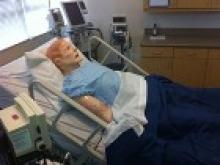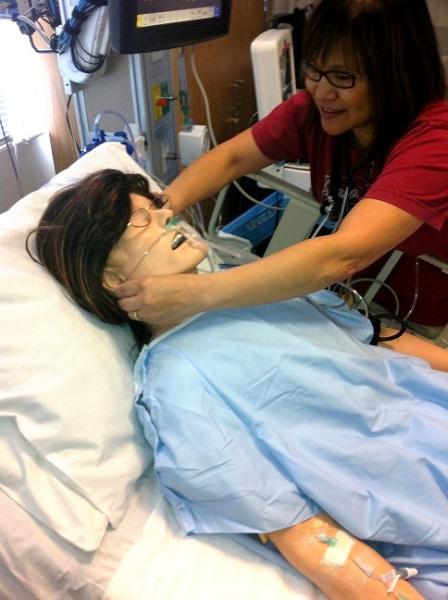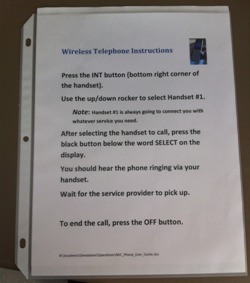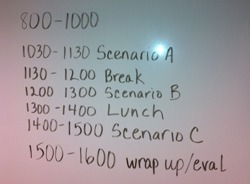Nursing Simulation - Design and Implementation

Edward J. Rovera, MS Ed, the School's Health Informatics Specialist, will be teaching Nursing Simulation Design and Implementation starting in Fall 2011. This course will be offered as N699 and N899 sections and is open to all nursing students who have successfully completed their Level III requirements. In other words, all Level IV, Level V, APO or RN-MSN nursing students are eligible. Any non-nursing students interested in learning about nursing simulation are also encouraged to speak with the instructor as well. Enrollment is capped at twenty students to keep this course to a manageable size.
 This course is designed for the person who wishes to develop their skills at mentoring their fellow students using the facilities of the Nursing Interventions Classroom (NIC) and the Nursing Simulation Complex (NSC). You will be working with the simulation staff to implement the scenarios for Level I, II & III simulation sessions. This includes set-up, break-down, being a confederate (i.e., an actor), and participating in post-simulation debriefings. You will also be able to work in the NIC, helping fellow students practice their skills. You will also be able to help in developing teaching and learning aids for use in preparing and executing simulation sessions in the NIC. You will have the opportunity to learn how to operate the mannequin software and the various recording equipment we have available in both the NIC and the NSC. Depending upon your interests, you will be able to get involved with any and all aspects of nursing simulation, from the most basic of skills training to the execution of high fidelity mannequin-based and standardized participant sessions.
This course is designed for the person who wishes to develop their skills at mentoring their fellow students using the facilities of the Nursing Interventions Classroom (NIC) and the Nursing Simulation Complex (NSC). You will be working with the simulation staff to implement the scenarios for Level I, II & III simulation sessions. This includes set-up, break-down, being a confederate (i.e., an actor), and participating in post-simulation debriefings. You will also be able to work in the NIC, helping fellow students practice their skills. You will also be able to help in developing teaching and learning aids for use in preparing and executing simulation sessions in the NIC. You will have the opportunity to learn how to operate the mannequin software and the various recording equipment we have available in both the NIC and the NSC. Depending upon your interests, you will be able to get involved with any and all aspects of nursing simulation, from the most basic of skills training to the execution of high fidelity mannequin-based and standardized participant sessions.
 You will be required to complete three projects related to nursing simulation as it is applied at the School of Nursing. The projects will range from creating and executing a simulation scenario to documenting how to set out the supplies for check off stations and creating brief educational videos for students coming in for their first simulation session. The projects will to be multi-person; you will not be required to do everything yourself. Part of what you are expected to learn is how to work with your peers to complete time-sensitive assignments. You will learn as much – if not more – from your fellow students as you will from the instructor. In addition, you will also be asked to help in operating the NIC and NSC for up to 40 hours during the semester. Again, depending upon your interests, these hours may include manning the NIC during Open Hours, preparing materials and mannequins for simulation sessions, helping man stations during check-off and simulation days, and participating in simulation sessions as a confederate or standardized participant (i.e., an actor playing a specific role).
You will be required to complete three projects related to nursing simulation as it is applied at the School of Nursing. The projects will range from creating and executing a simulation scenario to documenting how to set out the supplies for check off stations and creating brief educational videos for students coming in for their first simulation session. The projects will to be multi-person; you will not be required to do everything yourself. Part of what you are expected to learn is how to work with your peers to complete time-sensitive assignments. You will learn as much – if not more – from your fellow students as you will from the instructor. In addition, you will also be asked to help in operating the NIC and NSC for up to 40 hours during the semester. Again, depending upon your interests, these hours may include manning the NIC during Open Hours, preparing materials and mannequins for simulation sessions, helping man stations during check-off and simulation days, and participating in simulation sessions as a confederate or standardized participant (i.e., an actor playing a specific role).
 Below are the overview and objectives for this course. Review the information and if this sounds like something you want to do, contact Mr. Rovera for current details on enrollment. After talking with the instructor, you will need to complete the SFSU PETITION FOR COURSE BY INDEPENDENT STUDY (699/899). Once you have that filled out and signed, you will be assigned a permit number that will allow you to register for the course.
Below are the overview and objectives for this course. Review the information and if this sounds like something you want to do, contact Mr. Rovera for current details on enrollment. After talking with the instructor, you will need to complete the SFSU PETITION FOR COURSE BY INDEPENDENT STUDY (699/899). Once you have that filled out and signed, you will be assigned a permit number that will allow you to register for the course.
N699/N899 Overview
Course
Nursing 699/899 Nursing Simulation (Hybrid On-line Course)
Credit
3 Units
Day/Time/Place
TBA, BH 343 & BH 374 San Francisco State University
Faculty
Edward J. Rovera, MS Ed Office House: TBA
Pre-Requisites
For nursing students: Successful completion of all Semester 3 (Level III) nursing courses and signature of instructor. For non-nursing students: Completion of an interview with and signature of the instructor.
Course Description
Simulation design and implementation as it applies to nursing education. Development of skills necessary to successfully create a nursing simulation scenario and have it successfully used in a simulated clinical experience. Participation in the processes necessary to operate and maintain a nursing simulation program. Develop and perform peer mentoring and tutoring skills.
Special Note
This course is open to graduate as well as bachelor’s level students. The course number of 899 is used to differentiate graduate from Bachelor’s students for the University’s administrative and accounting requirements. In all other aspects, the course content, objectives, and requirements are the same for N699 and N899.
Course Objectives
At the completion of this course, students will be able to:
- Identify components of effective mentoring and leadership in nursing through the use of nursing simulation at multiple levels of complexity.
- Identify the various levels of simulation education employed in nursing education.
- Describe the main adult learning theories pertaining to simulation education in nursing.
- Describe the Quality and Safety Education for Nurses (QSEN) competencies.
- Develop a scenario for use in nursing simulation that meets at least three learning objectives for nursing education as defined within the QSEN competencies.
- Design and implement a simulation-related teaching/learning module.
- Identify design techniques and execution processes in nursing simulation.